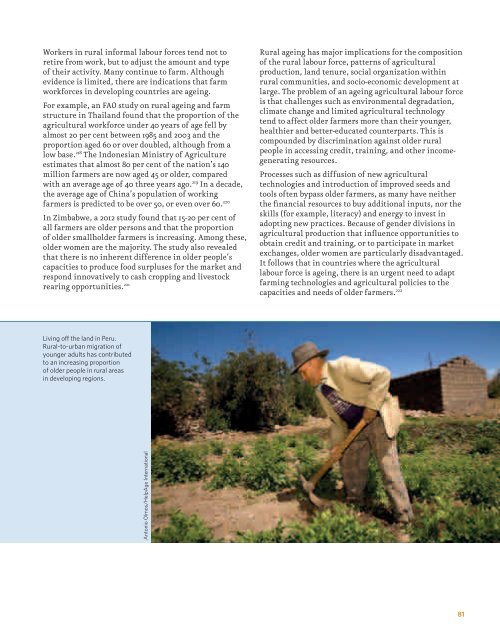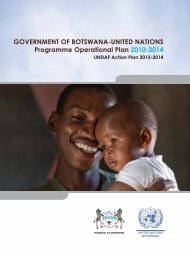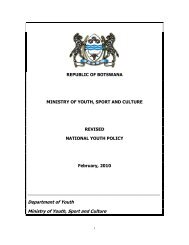Ageing in the Twenty-First Century: - HelpAge International
Ageing in the Twenty-First Century: - HelpAge International
Ageing in the Twenty-First Century: - HelpAge International
You also want an ePaper? Increase the reach of your titles
YUMPU automatically turns print PDFs into web optimized ePapers that Google loves.
Workers <strong>in</strong> rural <strong>in</strong>formal labour forces tend not to<br />
retire from work, but to adjust <strong>the</strong> amount and type<br />
of <strong>the</strong>ir activity. Many cont<strong>in</strong>ue to farm. Although<br />
evidence is limited, <strong>the</strong>re are <strong>in</strong>dications that farm<br />
workforces <strong>in</strong> develop<strong>in</strong>g countries are age<strong>in</strong>g.<br />
For example, an FAO study on rural age<strong>in</strong>g and farm<br />
structure <strong>in</strong> Thailand found that <strong>the</strong> proportion of <strong>the</strong><br />
agricultural workforce under 40 years of age fell by<br />
almost 20 per cent between 1985 and 2003 and <strong>the</strong><br />
proportion aged 60 or over doubled, although from a<br />
low base. 218 The Indonesian M<strong>in</strong>istry of Agriculture<br />
estimates that almost 80 per cent of <strong>the</strong> nation’s 140<br />
million farmers are now aged 45 or older, compared<br />
with an average age of 40 three years ago. 219 In a decade,<br />
<strong>the</strong> average age of Ch<strong>in</strong>a’s population of work<strong>in</strong>g<br />
farmers is predicted to be over 50, or even over 60. 220<br />
In Zimbabwe, a 2012 study found that 15-20 per cent of<br />
all farmers are older persons and that <strong>the</strong> proportion<br />
of older smallholder farmers is <strong>in</strong>creas<strong>in</strong>g. Among <strong>the</strong>se,<br />
older women are <strong>the</strong> majority. The study also revealed<br />
that <strong>the</strong>re is no <strong>in</strong>herent difference <strong>in</strong> older people’s<br />
capacities to produce food surpluses for <strong>the</strong> market and<br />
respond <strong>in</strong>novatively to cash cropp<strong>in</strong>g and livestock<br />
rear<strong>in</strong>g opportunities. 221<br />
Rural age<strong>in</strong>g has major implications for <strong>the</strong> composition<br />
of <strong>the</strong> rural labour force, patterns of agricultural<br />
production, land tenure, social organization with<strong>in</strong><br />
rural communities, and socio-economic development at<br />
large. The problem of an age<strong>in</strong>g agricultural labour force<br />
is that challenges such as environmental degradation,<br />
climate change and limited agricultural technology<br />
tend to affect older farmers more than <strong>the</strong>ir younger,<br />
healthier and better-educated counterparts. This is<br />
compounded by discrim<strong>in</strong>ation aga<strong>in</strong>st older rural<br />
people <strong>in</strong> access<strong>in</strong>g credit, tra<strong>in</strong><strong>in</strong>g, and o<strong>the</strong>r <strong>in</strong>comegenerat<strong>in</strong>g<br />
resources.<br />
Processes such as diffusion of new agricultural<br />
technologies and <strong>in</strong>troduction of improved seeds and<br />
tools often bypass older farmers, as many have nei<strong>the</strong>r<br />
<strong>the</strong> f<strong>in</strong>ancial resources to buy additional <strong>in</strong>puts, nor <strong>the</strong><br />
skills (for example, literacy) and energy to <strong>in</strong>vest <strong>in</strong><br />
adopt<strong>in</strong>g new practices. Because of gender divisions <strong>in</strong><br />
agricultural production that <strong>in</strong>fluence opportunities to<br />
obta<strong>in</strong> credit and tra<strong>in</strong><strong>in</strong>g, or to participate <strong>in</strong> market<br />
exchanges, older women are particularly disadvantaged.<br />
It follows that <strong>in</strong> countries where <strong>the</strong> agricultural<br />
labour force is age<strong>in</strong>g, <strong>the</strong>re is an urgent need to adapt<br />
farm<strong>in</strong>g technologies and agricultural policies to <strong>the</strong><br />
capacities and needs of older farmers. 222<br />
Liv<strong>in</strong>g off <strong>the</strong> land <strong>in</strong> Peru.<br />
Rural-to-urban migration of<br />
younger adults has contributed<br />
to an <strong>in</strong>creas<strong>in</strong>g proportion<br />
of older people <strong>in</strong> rural areas<br />
<strong>in</strong> develop<strong>in</strong>g regions.<br />
Antonio Olmos/<strong>HelpAge</strong> <strong>International</strong><br />
81







